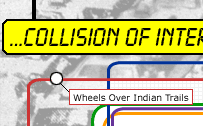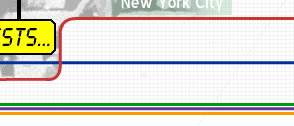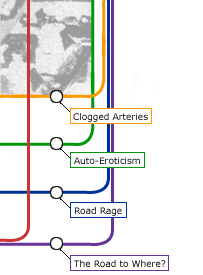



The Political Tool || Westway || The Stencilling Project || Carmageddon || Critical Mass || Critical Mass 10/31/00 || Fight for Oil
The Stencilling Project
Since December 1996, Right Of Way has stenciled over 250 "street memorials" to pedestrians and bicyclists killed by motor vehicles in New York City.
What are your memorials like?
Each street memorial consists of a set of painted stencils documenting the
name of a person killed by a motor vehicle and the date and
instrument of death ("automobile"). The image of a body
outline -- as though from a police crime scene -- stands in for the
deceased individual who is no longer here to represent him or
herself.
We use both first and last names, except when these souls have not been identified by authorities. Such individuals are described as unknown man or unknown woman. When the subject of a memorial is a child, we give just the first name, along with his or her age.
When more than one person has been killed at a single site, we group the names together alongside a single body outline.
Describe
a typical memorial
First,
there is the body outline, corresponding to a person 5½ feet
tall, but occupying a greater length due to the splayed arms and
legs. Then, underneath, the name and date of death (for example, LYN
AUSTIN 9-29-00), and, below that, KILLED BY AUTOMOBILE. In several
highly publicized instances where the person was killed by a
carelessly operated bus, we have stenciled KILLED BY BUS.
How
big is your crew, and how do they actually do the stenciling?
We
customarily stencil between a half-dozen and a dozen "sites"
during one outing. Our crews have been as small as two people, but
the favorite crew size is five or six -- sufficient for solidarity and
to manage the many tasks, but not too conspicuous.
We travel among the sites by bicycle, pulling the stencils in a hauler-trailer hitched to one of the bikes. When we arrive at a site, we first select a suitable area of pavement -- one that will be visible to the maximum number of passersby and that is also reasonably faithful to the location where the person was struck (noted from newspaper accounts or police reports).
One crew member sweeps the pavement with a whisk broom, while others pull the stencils from the crate, lay them out, and hold them down against the wind. Others then apply the paint. Typically, two people paint the body of the stencil, starting at either end and meeting in the middle, although a single person can do it. In either case, painters should start windward to avoid getting covered with paint.
While the painting is taking place, other crew members route passersby around the area or explain the action to bystanders. Two or more people then pack up the materials and re-attach the crate to the bike trailer, while the stencil is photographed and its location noted.
Most of our memorials are painted on sidewalks, to make them more readable and visible to the volume of pedestrians passing by. (They're not likely to be visible to people flying by in cars.) This also helps keep the images from being worn away by vehicle tires -- and is safer for the crew as well. Although this placement can lead viewers to infer that the victim was hit on the sidewalk when this was not the case, it is sometimes the best choice.
When it's safe to do so, though, stenciling in a crosswalk (for accidents that occurred there) makes a strong statement about the dangerousness of these supposedly "safe" pedestrian zones.
How
do you collect accident sites in advance? How do you select the sites
to be stenciled?
We
have two data sources: newspaper accounts (including New York's many
community papers, which are often a more complete source); and the NY
State Dept. of Motor Vehicles, which furnishes copies of police
accident reports through a "freedom of information" request
procedure involving long lead times and much red tape. We have no
standard selection process. The most common impetus is a particularly
poignant or heinous fatality, which we then combine with other sites
that may be geographically proximate or thematically linked (e.g.,
children killed in the same borough).
How
long do the memorials last?
Several
months or more, with duration depending on pavement, wear-and-tear,
weather, and so on. Body outlines can be refreshed periodically by
one person, without having to drag out the stencil form, as follows:
If the wind is light, simply re-spray the entire body outline,
keeping the paint can close to the pavement, connecting the "dashes"
(i.e., closing the gaps). The word sets (with name and date of
victim, and "KILLED BY AUTOMOBILE," can be carried around
relatively easily to refresh the name and date.
How
does the community react to these memorials? Do people decorate them
like shrines, with flowers, candles, and so on?
The
ephemeral nature of New York street life seems to prevent
pedestrian-death sites from becoming shrines on their own. Perhaps
because of this void, most reactions to our stenciling are
supportive. Not infrequently, passersby who knew the victim have
commented on his or her life and the manner of death, and have
thanked us for memorializing the person. On perhaps half-a-dozen
occasions, a family member has passed by, or been present by
arrangement, or has called or written subsequently to express
appreciation.
Additionally, our memorials have received wide and positive press coverage. Most important, the memorials are noticed by the thousands of pedestrians that pass a given site each day, so that the lives lost to automobile violence may be remembered and mourned.
Stencilers have been berated by passersby several times; the best reaction is to acknowledge the criticism politely and respectfully while continuing to complete the job. In the one instance in which a family member wrote to express anguish at seeing the body outline representing her mother, we wrote back apologizing for the intrusion and upset, while affirming the importance of raising awareness over the slaughter of people by automobiles.
Do
the authorities ever remove the images?
As
a rough guess, around three-quarters of our memorials remain
undisturbed until they eventually wear out. The other one-quarter are
deliberately obliterated or painted over -- by whom, we're not sure,
perhaps local residents or an adjacent store owner.
The three times that we painted stencils in city parks, the City Parks Department maintenance staff ground them out within 48 hours. But in most locations where we stencil, there's not really a "community" that would request either preservation or removal of our memorials.
What
paint do you use?
The
spray paints must be "inverted marking paints" -- designed
to work upside down. Our "palette" includes fluorescent
orange and high-visibility yellow. (For some reason, fluorescent
yellow is not available.) There are different shades of this yellow:
Rust-Oleum is paler than Krylon -- a bit too pale for use on a
concrete sidewalk. In any event, a sharper color contrast is achieved
when stencils are painted on black asphalt as opposed to the grey
sidewalk.
At one time, we used Grainger-branded paints, but Grainger now sells the Rust-Oleum. Krylon paints can be ordered through hardware stores that are part of the True Value chain; their supplier is a wholesaler known as Cotter. In quantity you should be able to negotiate a price with the hardware store owner. Grainger's Web site, which carries all of its products, is http://www.grainger.com/
The Rust-Oleum cans are 15 oz., and the Krylon are 17 oz. A single 15 oz. can of orange is sufficient for four to five body outlines, while one 15 oz. can of yellow makes around eight "word sets" (the stencil documenting the victim's name, date of crash, and the words KILLED BY AUTOMOBILE).
How
do you make your stencils?
We
make three sets of stencils. Two are reusable -- the body outline,
which, in a burst of gallows humor, we dubbed "flatso" --
and the stencil reading KILLED BY AUTOMOBILE. The third, which we
call a "word set," must be made specifically for each site;
it documents the victim's name and date of death.
We make word sets from two-inch high letters manufactured by Duro Stencil Co. of Chicago, available at True Value and some other hardware stores. (The Ace Hardware brand is also good, but the cards are a different size and don't fit in with our existing inventory.) Two dollars buys an entire alphabet as well as the numerals 0 through 9, plus a few extra popular letters. To tighten the spacing, we trim the sides of the letter stencils with a paper trimmer. Then with very small pieces of Scotch tape, we attach the letters together.
To make a frame for the word set, we buy 22" x 28" tag stock, fold it lengthwise (in the store), and cut it in half. (Note that the frame should extend several inches around the letters, so that mist from the spraying doesn't tarnish the pavement and dilute the pristine quality of the stencil image.) We lay the word set on the cut piece of stock and mark the insides of the corners of the word set. With a yardstick we draw two rectangles slightly larger than the indicated corner marks. Using a razor knife, we cut a hole, and place the word set on the bottom side. (Viewed from the top the word set is positioned inside the hole.) Using pieces of Scotch tape we fix the word set in position. Flipping the tag stock over, we wrap masking tape around the word set's perimeter.
The KILLED BY AUTOMOBILE and KILLED BY BUS stencils are made in the same manner as the word sets.
The flatso, or body outline, is two feet wide and six feet long, not counting the border, which adds several inches in both dimensions. It is made in four pieces, which are attached to each other with three hinges made of duct tape. Flatso has no lettering.
There is also a "child flatso" for youngsters, sadly enough. This design is much smaller than the adult flatso, perhaps three feet in height, with a softer, more rounded appearance.
What
tools does the crew carry?
We
make sure someone is carrying paper and a pen, to note the location
where the stencil is placed. At least one camera is needed for
documentation. Each crew carries a roll of masking or duct tape for
emergency flatso repairs, or to make a last-minute change to a
misspelled stencil.
Why
do you photograph the memorials?
Photographs
of our street memorials are powerful for the same reason that the
memorials themselves are powerful: the image of a fallen pedestrian
or cyclist, contorted yet at rest, in conjunction with the person's
name, the words KILLED BY AUTOMOBILE, and the date of the killing, is
disturbing . . . memorable . . . compelling. Not surprisingly, media,
particularly community papers and specialty magazines, have
collectively run dozens of these photographs. (Bigger media use their
own photographers.) Photographs of our memorials have also been
effective in conveying the depths of the tragedies wrought by car
violence to public officials and others. In a few instances, family
members have drawn comfort from them, feeling that someone cared
about and remembered their loved one.
Photographs taken at night tend to be more visually striking than those taken during the day. In the stark light of the camera's flash, the painted stencil shines against the black street. Daytime affords weaker contrast between the stenciled body outline and the street. However, daytime shots can more easily incorporate details of the surrounding street to supply context. We like shots of the crew in action, too, provided that folks don't mind being recorded.
Digital cameras are an efficient way to get the documents up on a Web site quickly so that our handiwork may be viewed by everyone in Right Of Way and other interested parties.
What
do you do if the police come by you're stenciling?
Once
one of our crews was caught red-handed. A cop stood over them as they
painted and asked, "What are you doing?" One crew member
responded, "We're memorializing the death of a fellow pedestrian
who was killed by a car at this intersection; we're hoping you'll be
okay with that." Officer: "I don't know what the rule book
says about this." Painter: "Well, I for one am hoping that
you'll give us a break." Officer: "Well, so long as you
don't block any cars, I guess it's alright."
Back to top